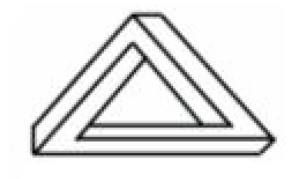If Physics demands an object, the next issue on the agenda is difficult to avoid. We need to define what an object is for the purposes of this discipline. We can’t begin to explain mechanisms until we covered this important base.
object: that which has shape
Shape is the only attribute that all objects have in common.
And if something is that which has shape, nothing is exactly the opposite: an antonym…
space: that which doesn’t have shape
At first impression, this definition would seem to be quite inoffensive. We all knew it, right? Kindergarten stuff!
Actually, this is not the definition that has always been applied or followed. Most people have the cursory notion of ordinary speech in mind: that which we can touch or see. We are so used to seeing and touching everyday things that we casually assume that those are the properties that define an object.
Then again, we cannot touch an impossible object such as a tribar. We can at best touch the paper or the ink where the image lies. And we certainly cannot see the air we breathe. Therefore, touch and see are not universal attributes of objects whereas shape definitely is. Can you imagine an object that does not have shape?
Nevertheless, touch, see, smell, taste, and hearing invariably invoke a second object: the witness. This would make the definition of object circular. We would have to invoke two objects in order to define the word object.
Just as self-defeating, the definition of object would be contingent on the interaction of these objects. The Moon would not be an object until an asteroid struck it. We need to run a test in which the senses of vision or touch are involved before we can call an elephant an object. This is not a definition, but a proof disguised as a definition: an operational or functional definition.
If we can’t see or touch a star on the other side of the Universe, does the word star not refer to an object? Is the Moon not an object to the blind man?
You can touch the paper and the ink, but you can’t touch a tribar.

…And, fortunately, we cannot see the air, for else that would be the only thing that we would see.


Lastly, the word object is a static concept; no motion is involved in its definition. The definition of the word object necessarily precedes the definition of motion. Only objects can perform actions. Hence, a scientific definition of object should embody no verbs, motion, or any of the five senses.
What is not readily apparent is that choosing shape rather than the touch/see criteria leads to radically different conclusions in Physics. This becomes evident when we converge upon the properties of the invisible mediators that Mother Nature uses to do her daily work.
The strategic word ‘object’ is a static concept. Its definition should not embody any movement or invoke any of the five senses. The only attribute that all objects have is form.
